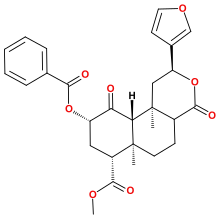Herkinorin
 | |
| Clinical data | |
|---|---|
| ATC code |
|
| Legal status | |
| Legal status |
|
| Identifiers | |
| |
| CAS Number | |
| PubChem CID | |
| ChemSpider | |
| UNII | |
| ChEMBL | |
| CompTox Dashboard (EPA) | |
| Chemical and physical data | |
| Formula | C28H30O8 |
| Molar mass | 494.540 g·mol−1 |
| 3D model (JSmol) | |
| |
| |
| | |
Herkinorin is an opioid analgesic that is an analogue of the natural product salvinorin A. It was discovered in 2005 during structure-activity relationship studies into neoclerodane diterpenes, the family of chemical compounds of which salvinorin A is a member.[1]
Unlike salvinorin A, which is a selective κ-opioid receptor agonist with no significant μ-opioid receptor affinity, herkinorin is predominantly a μ-opioid receptor agonist. Compared to salvinorin A, herkinorin has 47× lower affinity for κ-opioid receptors (Ki = 90 nM vs Ki = 1.9 nM), and at least 25× higher affinity for μ-opioid receptors (Ki = 12 nM vs Ki >1000 nM), where it acts as a full agonist (IC50 = 0.5 μM, Emax = 130% vs DAMGO).[2][3] Herkinorin is a semi-synthetic compound, made from salvinorin B, which is most conveniently made from salvinorin A by deacetylation, since, while both salvinorin A and salvinorin B are found in the plant Salvia divinorum, salvinorin A is present in larger quantities.[4]
A study in primates showed it to act peripherally as both a μ- and κ-opioid receptor agonist, with a fast onset of action. The study did not find any evidence of central activity in primates and questions whether herkinorin's effects are due entirely to peripheral binding.[5] Unlike most μ-opioid receptor agonists, herkinorin does not promote the recruitment of β-arrestin 2 to the intracellular domain of the μ-opioid receptor, or induce receptor internalization.[6] This means that herkinorin may not produce tolerance and dependence in the same way as other opioids, although some development of tolerance through other mechanisms has been observed,[7] and some other analogues related to herkinorin can recruit β-arrestins.[8]
See also
References
- ^ Harding WW, Tidgewell K, Byrd N, Cobb H, Dersch CM, Butelman ER, et al. (July 2005). "Neoclerodane diterpenes as a novel scaffold for mu opioid receptor ligands". Journal of Medicinal Chemistry. 48 (15): 4765–71. doi:10.1021/jm048963m. PMID 16033256.
- ^ Tidgewell K, Harding WW, Lozama A, Cobb H, Shah K, Kannan P, et al. (June 2006). "Synthesis of salvinorin A analogues as opioid receptor probes". Journal of Natural Products. 69 (6): 914–8. CiteSeerX 10.1.1.693.6345. doi:10.1021/np060094b. PMID 16792410.
- ^ Holden KG, Tidgewell K, Marquam A, Rothman RB, Navarro H, Prisinzano TE (November 2007). "Synthetic studies of neoclerodane diterpenes from Salvia divinorum: exploration of the 1-position". Bioorganic & Medicinal Chemistry Letters. 17 (22): 6111–5. doi:10.1016/j.bmcl.2007.09.050. PMC 2111044. PMID 17904842.
- ^ Tidgewell K, Harding WW, Schmidt M, Holden KG, Murry DJ, Prisinzano TE (October 2004). "A facile method for the preparation of deuterium labeled salvinorin A: synthesis of [2,2,2-2H3]-salvinorin A". Bioorganic & Medicinal Chemistry Letters. 14 (20): 5099–102. doi:10.1016/j.bmcl.2004.07.081. PMID 15380207.
- ^ Butelman ER, Rus S, Simpson DS, Wolf A, Prisinzano TE, Kreek MJ (October 2008). "The effects of herkinorin, the first mu-selective ligand from a salvinorin A-derived scaffold, in a neuroendocrine biomarker assay in nonhuman primates". The Journal of Pharmacology and Experimental Therapeutics. 327 (1): 154–60. doi:10.1124/jpet.108.140079. PMC 2614932. PMID 18593955.
- ^ Groer CE, Tidgewell K, Moyer RA, Harding WW, Rothman RB, Prisinzano TE, Bohn LM (February 2007). "An opioid agonist that does not induce mu-opioid receptor--arrestin interactions or receptor internalization". Molecular Pharmacology. 71 (2): 549–57. doi:10.1124/mol.106.028258. PMC 3926195. PMID 17090705.
- ^ Xu H, Partilla JS, Wang X, Rutherford JM, Tidgewell K, Prisinzano TE, et al. (March 2007). "A comparison of noninternalizing (herkinorin) and internalizing (DAMGO) mu-opioid agonists on cellular markers related to opioid tolerance and dependence". Synapse (Submitted manuscript). 61 (3): 166–75. doi:10.1002/syn.20356. PMID 17152090. S2CID 23678472.
- ^ Tidgewell K, Groer CE, Harding WW, Lozama A, Schmidt M, Marquam A, et al. (April 2008). "Herkinorin analogues with differential beta-arrestin-2 interactions". Journal of Medicinal Chemistry. 51 (8): 2421–31. doi:10.1021/jm701162g. PMC 2494883. PMID 18380425.
- Articles with short description
- Short description is different from Wikidata
- Drugs not assigned an ATC code
- Drugs with non-standard legal status
- Chemical pages without DrugBank identifier
- Articles without KEGG source
- Drugboxes which contain changes to verified fields
- Drugboxes which contain changes to watched fields
- Benzoate esters
- 3-Furyl compounds
- Kappa-opioid receptor agonists
- Methyl esters
- Peripherally selective drugs
- Semisynthetic opioids
- Lactones
- Dissociative drugs